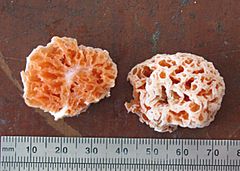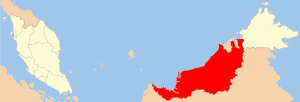Spongiforma squarepantsii facts for kids
Quick facts for kids Spongiforma squarepantsii |
|
|---|---|
 |
|
| Two halves of the fungus. A ruler is put at the bottom for scale. | |
| Scientific classification | |
| Kingdom: | |
| Division: | |
| Class: | |
| Order: |
Boletales
|
| Family: |
Boletaceae
|
| Genus: |
Spongiforma
|
| Species: |
S. squarepantsii
|
| Binomial name | |
| Spongiforma squarepantsii Desjardin, Peay & T.D.Bruns (2011)
|
|
 |
|
| A map of Sarawak, where Lambir Hills National Park is | |
Spongiforma squarepantsii is a very special type of fungus. It is part of the Boletaceae family and the Spongiforma genus. Scientists first discovered it in Malaysia in 2011. This fungus grows orange parts that look like sponges. These parts smell like fruit!
Contents
Discovering Spongiforma squarepantsii
Scientists found S. squarepantsii in 2011. It was discovered in the country of Malaysia. Specifically, it was found in a place called Lambir Hills National Park. This park is in the state of Sarawak.
What the Fungus Looks Like
The parts of the fungus that you can see are called fruit bodies. They are bright orange. These fruit bodies can grow quite large. They can be up to 10 centimeters wide. They can also be as tall as 7 centimeters.
Unique Features of the Fungus
One amazing thing about S. squarepantsii is its texture. It feels like a sponge. If you squeeze water out of it, it will go back to its original shape. This is very unusual for a fungus.
How the Fungus Spreads
Like other fungi, S. squarepantsii spreads using tiny spores. These spores are shaped like an almond. They are very small, about 10 to 12.5 μm wide. They are also about 6 to 7 µm deep.
The Name: SpongeBob SquarePants Fungus
The name Spongiforma squarepantsii is quite fun! It was named after the famous fictional character SpongeBob SquarePants. Scientists thought the fungus looked a lot like the cartoon character. This is why they gave it such a unique name.
Family of Spongiforma
S. squarepantsii is one of only two known types of fungi in the Spongiforma genus. The other type is called S. thailandica. Both of these fungi are known for their sponge-like appearance.
Images for kids
See also
 In Spanish: Spongiforma squarepantsii para niños
In Spanish: Spongiforma squarepantsii para niños


